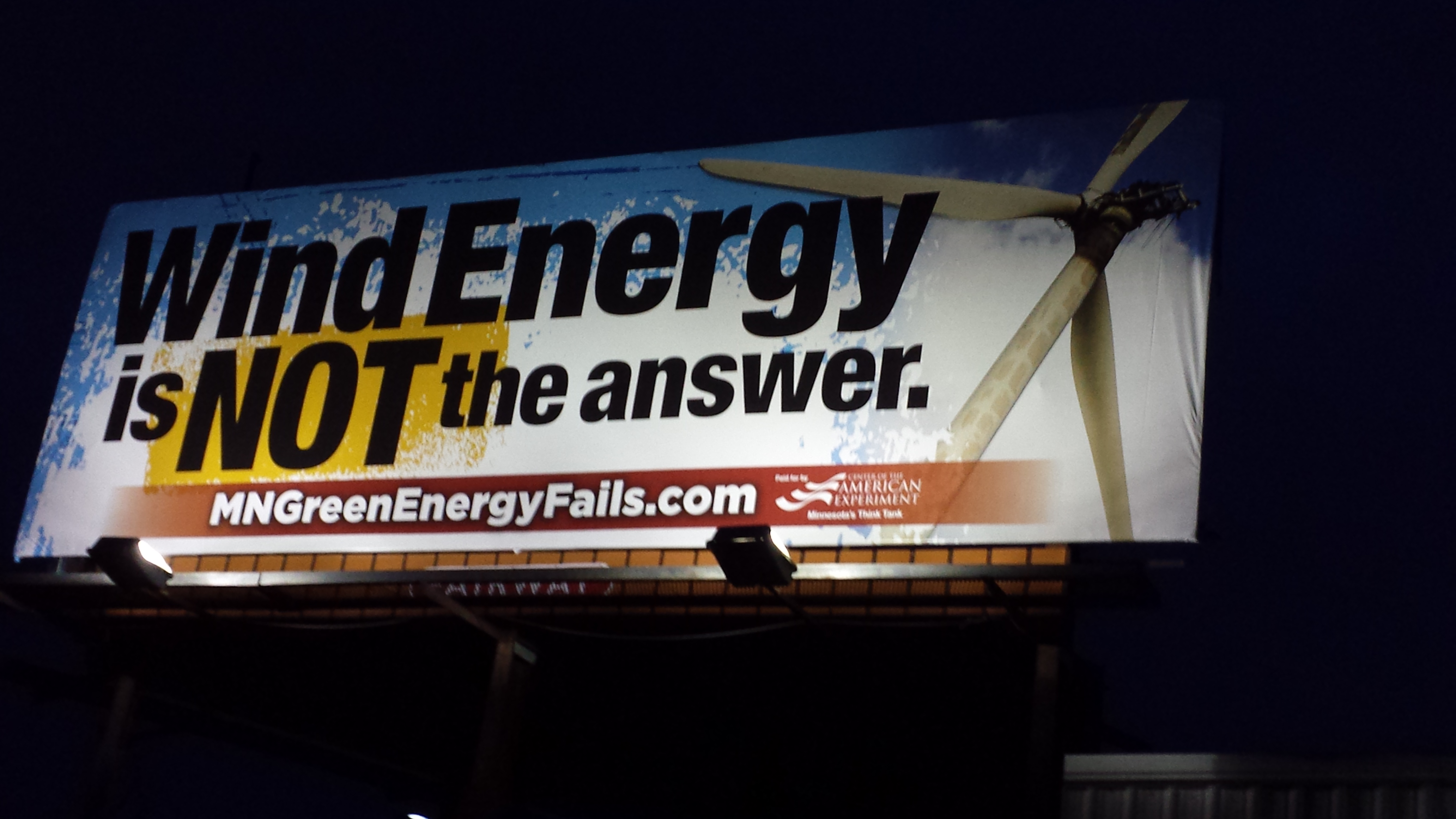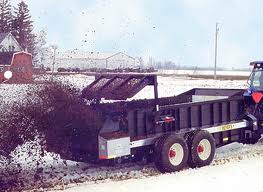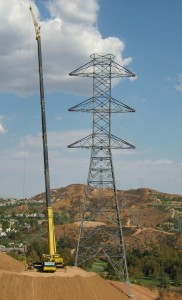 Seen on I-35 last night, right across from Cabelas
Seen on I-35 last night, right across from Cabelas
Last week, I saw the above sign on I-35 across from Cabelas. Today, Sunday, I saw another, just north of the Clarks Grove/251 exit, between the 19 and 20 mile markers. I’d guess with these two, there’d also be ones along I-90. There’s another one on Main in Albert Lea, near the lake; and another eastbound on I-90 near Hwy. 46 exit by Austin. Anyone see other billboards?
Where is Center of the American Experiment getting the money for this disinformation campaign? You may ask why I say “disinformation campaign.” Read on…
Check this out, the “report” they keep recycling:
Legalectric post from October:
Adding Power Purchase Agreement cost AND overnight cost (cost of developing and constructing) will of course be higher — you can’t have it both ways — pick one or the other!
Who benefits by CAE making arguments that don’t hold up to 30 seconds of research? CAE does of course, they’re filling their coffers. But they’re just on this because the funders want this result. The funders? I don’t presume that it’s as simple an answer as “The Koch Bros.” The false claims they use tells me it’s more nuanced, because they’re setting people up. Those who are sucked in to these arguments, who buy into these false claims, will be shot down by regulators and legislators who know the truth of what goes into rates, and who understand that CO2 reduction only happens by reducing burning, DOH! (not by increasing wind, increasing wind only changes the percentages). They’re sabotaging legitimate issues with wind siting, and they’re ignoring the groundbreaking recent demonstrations that wind projects DO violate the noise related permit conditions and Minnesota’s noise rule (Minn. Ch. 7030). They’re ignoring that the Minnesota Public Utilities Commission HAS ordered the violators to take action (too late, not enough, but a start). When there are legitimate issues, why would they ignore them and go for fake news? Why release the bogus CAE report a month after the Bent Tree Phase I report comes out? Hmmmmmmmm…
REAL NEWS:
Bent Tree_Noise Monitoring Phase I_20179-135856-01
Bent Tree Post-Construction Noise Monitoring Report Phase II Report
REAL NEWS: Freeborn Wind project is first ever wind siting contested case! For info, go HERE and search for docket “17” (year) “410” (docket number). Good reading!
These Minnesota Public Utilities Commission actions should be well known to CAE if they’re going to be doing a campaign like this. CAE should be spreading this info far and wide… but noooooo….
An example — the day before yesterday at the legislature, there they are touting this report again:
American Experiment Testifies in Front of MN House of Representatives Committee on Job Growth and Energy Affordability Policy on Wind Energy

Soooo, who benefits? Who benefits from CAE’s big PR push? Who benefits from uninformed people jumping on the CAE bandwagon, only to lose their credibility by spewing these CAE bogus arguments? I think this is a very well crafted disinformation campaign. Who is paying for it? Usually the Wizard is Xcel Energy, manipulating behind the scenes, spreading money far and wide to whoever will take it. Here? We shall see… And is any of this related to Senate File 3504/House File 3708 (they are identical) introduced on March 15th and 12th 2018?? Circumventing the PUC to get instant rate recovery for rehab of Prairie Island nuclear plant? We know how Monticello came in at twice the cost. How would that go here? PUC review of that might hamper Xcel. Can’t have that, can we… and we know CAE loves nuclear.
Registrant ContactName: Peter ZellerOrganization: Center of the American ExperimentStreet: 8421 Wayzata Blvd., Ste. 110City: Golden ValleyState: MNPostal Code: 55426Country: USPhone: +1.6123383605
Email:@americanexperiment.org
Getting railroaded?
February 2nd, 2010
We all know what a pain in the patoot siting transmission is (particularly when it’s not needed). And now for something completely different — an interesting and seemingly probable theory:
ARE Y’ALL PAYIN’ ATTENTION??!!!?!?!?!
This is one of those pieces that I want to preserve to take out and reread in the not too distant future:
Buffett’s Semaphore Signal: Should Burlington Northern Shareholders Think Again Before Saying ‘Yes’ To Berkshire Hathaway?
Author: Daniel Sinclair
Reasons commentators ascribe to Buffett’s offer to acquire one of North America’s largestrail networks, Burlington Northern Santa Fe (BNSF) are now familiar. Growing global trade, continued reliance on (especially low sulphur) coal, a resurgent and growing US economy (without needing to pick product ‘winners’ and ‘losers’), a low risk way to gain exposure to any rising process for commodities, a hedge against inflation given rail’s pricing power, a competitive advantage in rail’s oligopoly and high barriers to entry, more productive rail with more efficient and technologically advanced operations and a rise double-decker railway carriages, a way to play higher oil prices and cap and trade or carbon tax laws given that rail is 3 to 4 times more fuel efficient than trucks.
Those reasons are all good, and they have been part of the core investment thesis for rail. But, it is submitted, there may be something extra that offers compelling upside to rail that has Buffett excited. Think about all the land that rail owns. BNSF, for example, operates one of the largest railroad networks in North America with about 32,000 route miles of track plus an additional 23,000 miles for other rail related infrastructure and property. Much of this land is of relatively little value beyond the use of rail. No one is going to build condos or hotels or new subdivisions along side railways.
